Summary的写作技巧和常见句型
summary怎么写
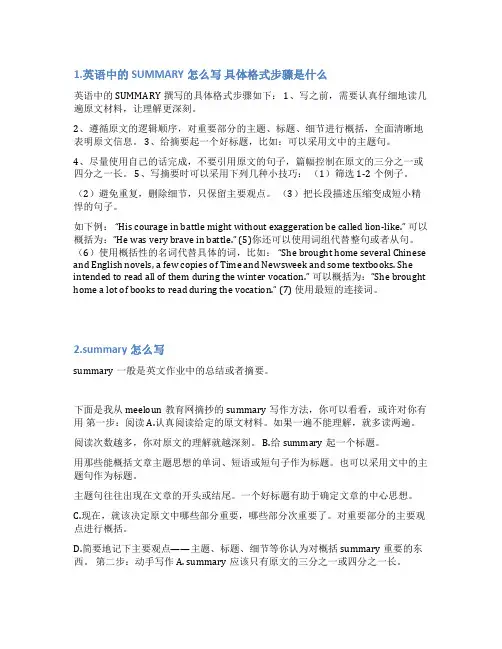
1.英语中的SUMMARY怎么写具体格式步骤是什么英语中的SUMMARY撰写的具体格式步骤如下: 1、写之前,需要认真仔细地读几遍原文材料,让理解更深刻。
2、遵循原文的逻辑顺序,对重要部分的主题、标题、细节进行概括,全面清晰地表明原文信息。
3、给摘要起一个好标题,比如:可以采用文中的主题句。
4、尽量使用自己的话完成,不要引用原文的句子,篇幅控制在原文的三分之一或四分之一长。
5、写摘要时可以采用下列几种小技巧:(1)筛选1-2个例子。
(2)避免重复,删除细节,只保留主要观点。
(3)把长段描述压缩变成短小精悍的句子。
如下例:“His courage in battle might without exaggeration be called lion-like.” 可以概括为:”He was very brave in battle.” (5)你还可以使用词组代替整句或者从句。
(6)使用概括性的名词代替具体的词,比如:“She brought home several Chinese and English novels, a few copies of Time and Newsweek and some textbooks. She intended to read all of them during the winter vocation.” 可以概括为:”She brought home a lot of books to read during the vocation.” (7) 使用最短的连接词。
2.summary怎么写summary一般是英文作业中的总结或者摘要。
下面是我从meeloun教育网摘抄的summary写作方法,你可以看看,或许对你有用第一步:阅读 A.认真阅读给定的原文材料。
如果一遍不能理解,就多读两遍。
阅读次数越多,你对原文的理解就越深刻。
B.给summary起一个标题。
Summary的写作技巧和常见句型
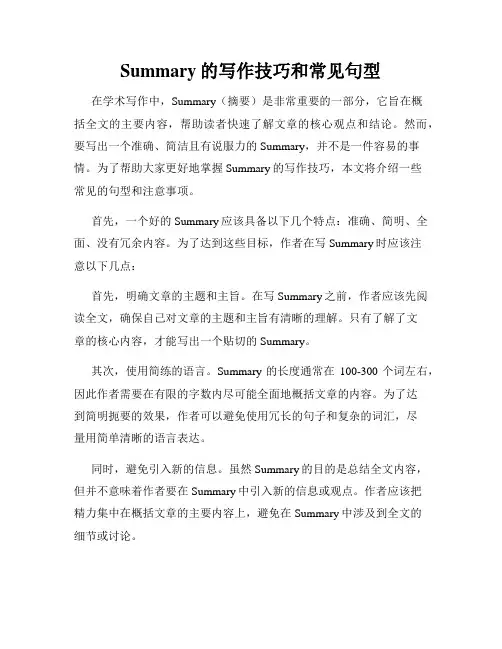
Summary的写作技巧和常见句型在学术写作中,Summary(摘要)是非常重要的一部分,它旨在概括全文的主要内容,帮助读者快速了解文章的核心观点和结论。
然而,要写出一个准确、简洁且有说服力的Summary,并不是一件容易的事情。
为了帮助大家更好地掌握Summary的写作技巧,本文将介绍一些常见的句型和注意事项。
首先,一个好的Summary应该具备以下几个特点:准确、简明、全面、没有冗余内容。
为了达到这些目标,作者在写Summary时应该注意以下几点:首先,明确文章的主题和主旨。
在写Summary之前,作者应该先阅读全文,确保自己对文章的主题和主旨有清晰的理解。
只有了解了文章的核心内容,才能写出一个贴切的Summary。
其次,使用简练的语言。
Summary的长度通常在100-300个词左右,因此作者需要在有限的字数内尽可能全面地概括文章的内容。
为了达到简明扼要的效果,作者可以避免使用冗长的句子和复杂的词汇,尽量用简单清晰的语言表达。
同时,避免引入新的信息。
虽然Summary的目的是总结全文内容,但并不意味着作者要在Summary中引入新的信息或观点。
作者应该把精力集中在概括文章的主要内容上,避免在Summary中涉及到全文的细节或讨论。
此外,注意使用一些常见的句型来连接句子,使Summary更加连贯和流畅。
以下是一些常用的句型:1. Overall, the article/book/paper gives a detailed analysis of...2. In conclusion, the author argues that...3. The study provides valuable insights into...4. From the findings/results, it can be inferred that...5. The research sheds light on the importance of...6. In summary, the main idea of the article is...总之,写Summary并不是难事,关键在于把握好文章的主题和主要内容,使用简练清晰的语言进行概括。
summary写作技巧
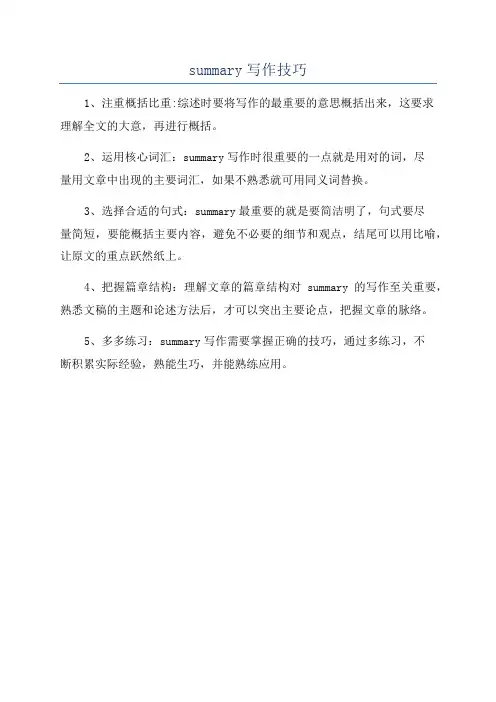
summary写作技巧
1、注重概括比重:综述时要将写作的最重要的意思概括出来,这要求
理解全文的大意,再进行概括。
2、运用核心词汇:summary写作时很重要的一点就是用对的词,尽
量用文章中出现的主要词汇,如果不熟悉就可用同义词替换。
3、选择合适的句式:summary最重要的就是要简洁明了,句式要尽
量简短,要能概括主要内容,避免不必要的细节和观点,结尾可以用比喻,让原文的重点跃然纸上。
4、把握篇章结构:理解文章的篇章结构对summary的写作至关重要,熟悉文稿的主题和论述方法后,才可以突出主要论点,把握文章的脉络。
5、多多练习:summary写作需要掌握正确的技巧,通过多练习,不
断积累实际经验,熟能生巧,并能熟练应用。
SUMMARY 格式及模板
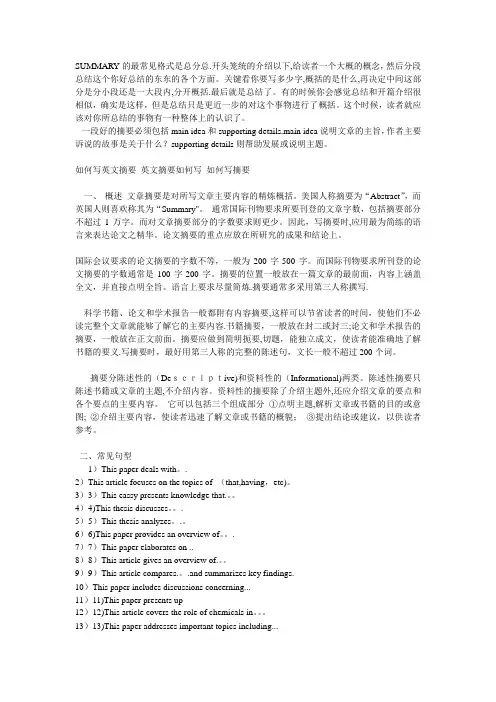
SUMMARY的最常见格式是总分总.开头笼统的介绍以下,给读者一个大概的概念,然后分段总结这个你好总结的东东的各个方面。
关键看你要写多少字,概括的是什么,再决定中间这部分是分小段还是一大段内,分开概括.最后就是总结了。
有的时候你会感觉总结和开篇介绍很相似,确实是这样,但是总结只是更近一步的对这个事物进行了概括。
这个时候,读者就应该对你所总结的事物有一种整体上的认识了。
一段好的摘要必须包括main idea和supporting details.main idea说明文章的主旨,作者主要诉说的故事是关于什么?supporting details则帮助发展或说明主题。
如何写英文摘要英文摘要如何写如何写摘要一、概述文章摘要是对所写文章主要内容的精炼概括。
美国人称摘要为“Abstract”,而英国人则喜欢称其为“Summary"。
通常国际刊物要求所要刊登的文章字数,包括摘要部分不超过1万字。
而对文章摘要部分的字数要求则更少。
因此,写摘要时,应用最为简练的语言来表达论文之精华。
论文摘要的重点应放在所研究的成果和结论上。
国际会议要求的论文摘要的字数不等,一般为200字-500字。
而国际刊物要求所刊登的论文摘要的字数通常是100字-200字。
摘要的位置一般放在一篇文章的最前面,内容上涵盖全文,并直接点明全旨。
语言上要求尽量简炼.摘要通常多采用第三人称撰写.科学书籍、论文和学术报告一般都附有内容摘要,这样可以节省读者的时间,使他们不必读完整个文章就能够了解它的主要内容.书籍摘要,一般放在封二或封三;论文和学术报告的摘要,一般放在正文前面。
摘要应做到简明扼要,切题,能独立成文,使读者能准确地了解书籍的要义.写摘要时,最好用第三人称的完整的陈述句,文长一般不超过200个词。
摘要分陈述性的(Descriptive)和资料性的(Informational)两类。
陈述性摘要只陈述书籍或文章的主题,不介绍内容。
资料性的摘要除了介绍主题外,还应介绍文章的要点和各个要点的主要内容。
英文写作(论文)中Summary常用句式
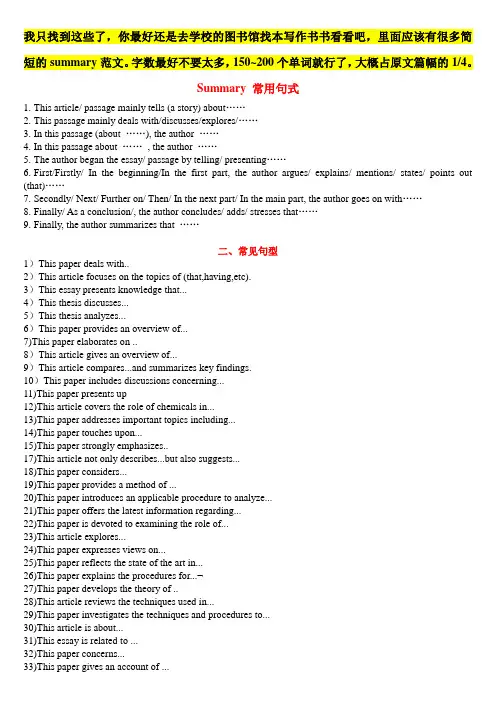
我只找到这些了,你最好还是去学校的图书馆找本写作书书看看吧,里面应该有很多简短的summary范文。
字数最好不要太多,150~200个单词就行了,大概占原文篇幅的1/4。
Summary 常用句式1.This article/ passage mainly tells (a story) about……2.This passage mainly deals with/discusses/explores/……3.In this passage (about ……), the author ……4.In this passage about ……, the author ……5.The author began the essay/ passage by telling/ presenting……6.First/Firstly/ In the beginning/In the first part, the author argues/ explains/ mentions/ states/ points out (that)……7.Secondly/ Next/ Further on/ Then/ In the next part/ In the main part, the author goes on with……8.Finally/ As a conclusion/, the author concludes/ adds/ stresses that……9.Finally, the author summarizes that ……二、常见句型1)This paper deals with..2)This article focuses on the topics of (that,having,etc).3)This essay presents knowledge that...4)This thesis discusses...5)This thesis analyzes...6)This paper provides an overview of...7)This paper elaborates on ..8)This article gives an overview of...9)This article compares...and summarizes key findings.10)This paper includes discussions concerning...11)This paper presents up12)This article covers the role of chemicals in...13)This paper addresses important topics including...14)This paper touches upon...15)This paper strongly emphasizes..17)This article not only describes...but also suggests...18)This paper considers...19)This paper provides a method of ...20)This paper introduces an applicable procedure to analyze...21)This paper offers the latest information regarding...22)This paper is devoted to examining the role of...23)This article explores...24)This paper expresses views on...25)This paper reflects the state of the art in...26)This paper explains the procedures for...¬27)This paper develops the theory of ..28)This article reviews the techniques used in...29)This paper investigates the techniques and procedures to...30)This article is about...31)This essay is related to ...32)This paper concerns...33)This paper gives an account of ...34)This article tells of...35)This paper tries to describe...36)This paper provides an analysis of ...37)This paper reports the latest information on ..38)The author of this article reviews..39)The writer of this paper discusses...40)The writer of this essay tries to explore...41)The aim of this paper is to determine..42)The purpose of this article is to review...43)The objective of this paper is to explore...破题用语,一般有:①The author of this article reviews (or: discusses, describes, summarizes, examines) something……②This article reviews (or:reports,tells of,is about,concerns)something…….③This article has been prepared (or:designed,written)…….④The purpose of this article is to determine something…….⑤The problem of something is discussed …….结论和建议,一般有以下几种写法:①The author suggests (recommends,concludes)that…….②This article shows that…….③It is suggested that…….④The author's suggestion (or:conclusion )is that ……⑤The author finds it necessary to …….Useful Transitions and Transitional Phrases Introduction to a Topic as for, concerning, with regard to, with respect to, in terms ofTo Summarize in all, in a word, in brief, briefly, in other words, in short, in summary, that is, finally, generally, in conclusion, on the whole, therefore, to sum up, to conclude, and so, this shows, thus we seeTo Compare by comparison, here again, in the same way, in a similar manner, likewise, similarly, so too, as, also, equally, accordingly, moreover, as well, andTo Contrast conversely, however, instead (of), in spite of that, anyhow, on the contrary, on the other hand, otherwise, rather than, still, yet, nevertheless, in contrast, notwithstanding, in spite of this, although, but, despite, even thoughTo Show Cause and Effect accordingly, as a consequence, as a result, consequently, for this reason, hence, it follows that, so/so that, then, therefore, thus, thereuponTo Explain actually, admittedly, because, certainly, for example, in fact, indeed, really of course, since, that is, for instance, namely, specifically, such as, to illustrate, in particular, in this manner, thusTo Show Conviction after all, at least, at the same time, apparently, even so, evidently, certainly, conceivably, conclusively, doubtless, no doubt, perhaps, possibly, presumably, probably, surely, undoubtedlyTo Show Various Conditions in this event, in these circumstances, this (that) being so, provided that,in spite of, none/nevertheless, at the same time, even if, if, unless, otherwise, although, even though, though, despiteTo Add Information add to this, again, also, besides, equally, further, furthermore, in addition, moreover, once more, then too, too, yet again, yet another, and, as well, beyond that, even, next, similarlyTo Show Chronological Order after that, afterwards, later, shortly, subsequently, concurrently, in the meantime, in the meanwhile, now, simultaneously, when/while/was, first, second, etc., formerly, earlier, previously, before that, then, already, at last, at length, by that time, finally, during, immediately, next, soon, still, in the interim, presently, at the same time, in the end, temporarily, thereafterTo Show Concession admittedly, after all, all the same, at any rate, granted, however, in any case, in spite of, it is true that, nevertheless, obviously, of course, still, to be sureLocation above, below, beyond, farther, further, here, nearby, opposite, there, to t。
有关summary的写作技巧
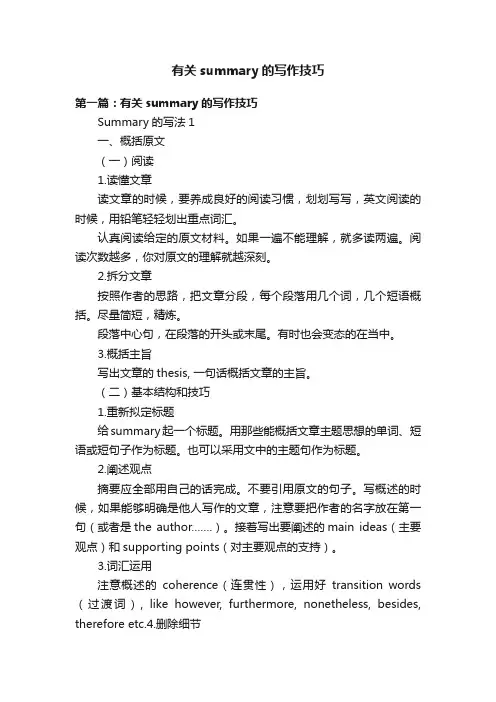
有关summary的写作技巧第一篇:有关summary的写作技巧Summary的写法1一、概括原文(一)阅读1.读懂文章读文章的时候,要养成良好的阅读习惯,划划写写,英文阅读的时候,用铅笔轻轻划出重点词汇。
认真阅读给定的原文材料。
如果一遍不能理解,就多读两遍。
阅读次数越多,你对原文的理解就越深刻。
2.拆分文章按照作者的思路,把文章分段,每个段落用几个词,几个短语概括。
尽量简短,精炼。
段落中心句,在段落的开头或末尾。
有时也会变态的在当中。
3.概括主旨写出文章的thesis, 一句话概括文章的主旨。
(二)基本结构和技巧1.重新拟定标题给summary起一个标题。
用那些能概括文章主题思想的单词、短语或短句子作为标题。
也可以采用文中的主题句作为标题。
2.阐述观点摘要应全部用自己的话完成。
不要引用原文的句子。
写概述的时候,如果能够明确是他人写作的文章,注意要把作者的名字放在第一句(或者是the author…….)。
接着写出要阐述的main ideas(主要观点)和supporting points(对主要观点的支持)。
3.词汇运用注意概述的coherence(连贯性),运用好transition words (过渡词), like however, furthermore, nonetheless, besides, therefore etc.4.删除细节只保留主要观点。
5.选择一至两个有代表性的例子原文中可能包括5个或更多的例子,你只需从中筛选一至二个例子。
6.把长句变成短句,把长段的描述变成短小、简单的句子。
“ He was hard up for money and was being pressed by his creditor.” 可以概括为:“He was in financial difficulties.”“His courage in battle might without exaggeration be called lion-like.” 可以概括为:”He was very brave in battle.”“He was hard up for mone y and was being pressed by his creditor.” 可以概括为:“He was in financial difficulties.”6)你还可以使用词组代替整句或者从句。
Summary的写作技巧和常见句型
Summary的写作技巧和常见句型2.阐述观点摘要应全部用自己的话完成。
不要引用原文的句子。
写概述的时候,如果能够明确是他人写作的文章,注意要把作者的名字放在第一句(或者是the author…….)。
接着写出要阐述的main ideas(主要观点)和supporting points(对主要观点的支持)。
3.词汇运用注意概述的coherence(连贯性),运用好transition words(过渡词), like however, furthermore, nonetheless, besides, therefore etc.4.删除细节只保留主要观点。
5.选择一至两个有代表性的例子原文中可能包括5个或更多的例子,你只需从中筛选一至二个例子。
6.把长句变成短句,把长段的描述变成短小、简单的句子。
“He was hard up for money and was being pressed by his creditor.”可以概括为:“He was in financial difficulties.”“His courage in battle might without exaggeration be called lion-like.”可以概括为:”He was very brave in battle.”“He was hard up for money and was being pressed by his creditor.”可以概括为:“He was in financial difficulties.”6) 你还可以使用词组代替整句或者从句。
请看下面的例子:“Beautiful mountains like Mount Tai, Lushan Mountain, and Mount Huang, were visited by only a few people in the past. Today, better wages, holidays with pay, new hotels on these mountains, and better train and bus services, have brought them within reach of many who never thought of visiting them ten years ago.”可以概括为:”Beautiful mountains like Mount Tai, once visited by only a few people, are today accessible to many, thanks to better wages, paid holidays, new hotels and better transportation services.”7) 使用概括性的名词代替具体的词,比如:“She brought home several Chinese and English novels, a few copies of Time and Newsweek and some textbooks. She intended to read all of them during the winter vocation.”可以概括为:”She brought home a lot of books to read during the vocation.”8)使用最短的连接词。
SUMMARY 格式及模板
SUMMARY的最常见格式是总分总。
开头笼统的介绍以下,给读者一个大概的概念,然后分段总结这个你好总结的东东的各个方面.关键看你要写多少字,概括的是什么,再决定中间这部分是分小段还是一大段内,分开概括.最后就是总结了。
有的时候你会感觉总结和开篇介绍很相似,确实是这样,但是总结只是更近一步的对这个事物进行了概括.这个时候,读者就应该对你所总结的事物有一种整体上的认识了.一段好的摘要必须包括main idea和supporting details。
main idea说明文章的主旨,作者主要诉说的故事是关于什么?supporting details则帮助发展或说明主题。
如何写英文摘要英文摘要如何写如何写摘要一、概述文章摘要是对所写文章主要内容的精炼概括。
美国人称摘要为“Abstract”,而英国人则喜欢称其为“Summary”。
通常国际刊物要求所要刊登的文章字数,包括摘要部分不超过1万字。
而对文章摘要部分的字数要求则更少。
因此,写摘要时,应用最为简练的语言来表达论文之精华。
论文摘要的重点应放在所研究的成果和结论上.国际会议要求的论文摘要的字数不等,一般为200字—500字。
而国际刊物要求所刊登的论文摘要的字数通常是100字—200字.摘要的位置一般放在一篇文章的最前面,内容上涵盖全文,并直接点明全旨.语言上要求尽量简炼。
摘要通常多采用第三人称撰写。
科学书籍、论文和学术报告一般都附有内容摘要,这样可以节省读者的时间,使他们不必读完整个文章就能够了解它的主要内容。
书籍摘要,一般放在封二或封三;论文和学术报告的摘要,一般放在正文前面.摘要应做到简明扼要,切题,能独立成文,使读者能准确地了解书籍的要义。
写摘要时,最好用第三人称的完整的陈述句,文长一般不超过200个词.摘要分陈述性的(Descriptive)和资料性的(Informational)两类。
陈述性摘要只陈述书籍或文章的主题,不介绍内容.资料性的摘要除了介绍主题外,还应介绍文章的要点和各个要点的主要内容。
英语summary万能模板
英语summary万能模板一、引言在学习英语过程中,经常会遇到阅读材料并写摘要的情况。
写好一篇英语summary对于提高阅读能力、加强语言表达能力都很重要。
本文将为大家提供一个万能的英语summary模板,帮助大家写出高质量的摘要。
二、模板结构一个好的英语summary应当具备清晰的结构,包括以下几个部分:1. 摘要开头在摘要的开头,可以简要介绍文章的主题、作者、出版时间等关键信息。
同时,通过一个简洁的句子引出文章的主要内容。
2. 摘要主体在摘要的主体部分,可以分几个段落来概括文章的主要观点和论据。
尽量用简洁的语言表达,不要使用细节丰富的描述。
3. 摘要结尾在摘要的结尾,可以总结文章的主要观点,并提出自己的看法。
也可以指出文章的不足之处或者下一步的研究方向。
三、模板示例文章标题:The Benefits of Regular Exercise on Mental Health引言This article discusses the benefits of regular exercise on mental health. It was written by John Smith and published in The Health Journal in 2020.摘要主体The article begins by highlighting the fact that regular exercise has numerous benefits for mental health. It boosts mood and reduces symptoms of anxiety and depression. The author cites a study conducted on a sample of 500 individuals who engaged in regular exercise for at least 30 minutes a day. The study found that these individuals reported fewer symptoms of depression compared to those who did not exercise regularly.Furthermore, the article emphasizes the role of exercise in stress reduction. Exercise releases endorphins in the body, which are natural mood enhancers. Therelease of endorphins during exercise helps to reduce stress and promote a sense of well-being. The author also explains that exercise can improve cognitive function and boost memory and concentration.The article also discusses the impact of exercise on sleep quality. Regular exercise helps regulate sleep patterns and can improve the quality of sleep. The author cites a study conducted on individuals with insomnia, where exercise was found to be an effective intervention in improving sleep quality.摘要结尾In conclusion, the article highlights the positive effects of regular exercise on mental health. It provides evidence that exercise can improve mood, reduce symptoms of anxiety and depression, reduce stress, improve cognitive function, and enhance sleep quality. It is recommended that individuals incorporate regular exercise into their daily routines to reap these mental health benefits.四、总结通过使用以上的万能summary模板,我们可以更加轻松地写出高质量的英语摘要。
(完整word版)SUMMARY 格式及模板
SUMMARY的最常见格式是总分总.开头笼统的介绍以下,给读者一个大概的概念,然后分段总结这个你好总结的东东的各个方面。
关键看你要写多少字,概括的是什么,再决定中间这部分是分小段还是一大段内,分开概括。
最后就是总结了。
有的时候你会感觉总结和开篇介绍很相似,确实是这样,但是总结只是更近一步的对这个事物进行了概括.这个时候,读者就应该对你所总结的事物有一种整体上的认识了.一段好的摘要必须包括main idea和supporting details.main idea说明文章的主旨,作者主要诉说的故事是关于什么?supporting details则帮助发展或说明主题。
如何写英文摘要英文摘要如何写如何写摘要一、概述文章摘要是对所写文章主要内容的精炼概括。
美国人称摘要为“Abstract”,而英国人则喜欢称其为“Summary”。
通常国际刊物要求所要刊登的文章字数,包括摘要部分不超过1万字.而对文章摘要部分的字数要求则更少。
因此,写摘要时,应用最为简练的语言来表达论文之精华。
论文摘要的重点应放在所研究的成果和结论上。
国际会议要求的论文摘要的字数不等,一般为200字—500字。
而国际刊物要求所刊登的论文摘要的字数通常是100字-200字。
摘要的位置一般放在一篇文章的最前面,内容上涵盖全文,并直接点明全旨.语言上要求尽量简炼.摘要通常多采用第三人称撰写.科学书籍、论文和学术报告一般都附有内容摘要,这样可以节省读者的时间,使他们不必读完整个文章就能够了解它的主要内容.书籍摘要,一般放在封二或封三;论文和学术报告的摘要,一般放在正文前面。
摘要应做到简明扼要,切题,能独立成文,使读者能准确地了解书籍的要义。
写摘要时,最好用第三人称的完整的陈述句,文长一般不超过200个词.摘要分陈述性的(Descriptive)和资料性的(Informational)两类。
陈述性摘要只陈述书籍或文章的主题,不介绍内容。
资料性的摘要除了介绍主题外,还应介绍文章的要点和各个要点的主要内容. 它可以包括三个组成部分①点明主题,解析文章或书籍的目的或意图;②介绍主要内容,使读者迅速了解文章或书籍的概貌;③提出结论或建议,以供读者参考.二、常见句型1)This paper deals with.。
- 1、下载文档前请自行甄别文档内容的完整性,平台不提供额外的编辑、内容补充、找答案等附加服务。
- 2、"仅部分预览"的文档,不可在线预览部分如存在完整性等问题,可反馈申请退款(可完整预览的文档不适用该条件!)。
- 3、如文档侵犯您的权益,请联系客服反馈,我们会尽快为您处理(人工客服工作时间:9:00-18:30)。
S u m m a r y 的写作技巧和常见句型、概括原文一)阅读1. 读懂文章读文章的时候,要养成良好的阅读习惯,划划写写,英文阅读的时候,用铅笔轻轻划出重点词汇。
认真阅读给定的原文材料。
如果一遍不能理解,就多读两遍。
阅读次数越多,你对原文的理解就越深刻。
2. 拆分文章按照作者的思路,把文章分段,每个段落用几个词,几个短语概括。
尽量简短,精炼。
段落中心句,在段落的开头或末尾。
有时也会变态的在当中。
3. 概括主旨写出文章的thesis, 一句话概括文章的主旨。
二)基本结构和技巧1.重新拟定标题给summary 起一个标题。
用那些能概括文章主题思想的单词、短语或短句子作为标题。
也可以采用文中的主题句作为标题。
2. 阐述观点摘要应全部用自己的话完成。
不要引用原文的句子。
写概述的时候,如果能够明确是他人写作的文章,注意要把作者的名字放在第一句(或者是接着写出要阐述的main ideas (主要观点)和supporting points (对主要观点的the author .. )。
支持)。
3. 词汇运用注意概述的cohere nee (连贯性),运用好tran siti on words (过渡词), like however,furthermore, nonetheless, besides, thereforeetc.4. 删除细节只保留主要观点。
5. 选择一至两个有代表性的例子原文中可能包括5 个或更多的例子,你只需从中筛选一至二个例子。
6. 把长句变成短句,把长段的描述变成短小、简单的句子。
He was hard up for money and was being pressed by hiscreditor.可以概括为:“ He was in finan cialdifficulties.His courage in battle might without exaggeration be called lion- like. ”可以概括为:” He was very brave inbattle.He was hard up for money and was being pressed by hiscreditor.可以概括为:“ He was in finan cialdifficulties.6)你还可以使用词组代替整句或者从句。
请看下面的例子:Beautiful mountains like Mount Tai, Lushan Mountain, and Mount Huang, werevisited by only a few people in the past. Today, better wages, holidays with pay, new hotels on these mountains, and better train and bus services, havebrought them within reach of many who never thought of visiting themtenyearsago. ”可以概括为:” Beautiful mountains like Mount Tai, once visited by only a few people, are today accessible to many, thanks to better wages, paid holidays,new hotels and better transportationservices.7) 使用概括性的名词代替具体的词,比如:She brought home several Chinese and English novels, a few copies of Timeand Newsweek and some textbooks. She intended to read all of themduringthe winter vocation. ”可以概括为:” She brought home a lot of books to read during thevocation.8)使用最短的连接词。
比如,可以使用but, then, thus, yet,though,不能使用at the same time, in the first place, because of these, on the other hand等较长的连接词。
通常,使用分号就能够达成使用连接词的效果。
9) 文章中的第一人称说的话通常在摘要中转换成第三人称,从而把大段的对白简化,比如:Kate looked at Paul disapprovingly: You use muchtoo much salt on your food,Paul —it 's not good for you!” Paul put down his knife and frowned: ”Whyon earth not! If you didn 't have salt on your food it would taste awfullike eati ng cardboard or sand •…just imag ine bread wit hout salt in it, orpotatoes or pasta cooked without salt! ” Kate was patient. She didn 't wantto quarrel with Paul. She wanted to persuade him. She said firmly: ”But toomuch salt is bad for you. It cause high blood pressure andlatter on,heart-attacks. It also disguises the taste of food, the realtastes whichare much more subtle than salt, and which we have lost thesensitivity toappreciate any more. ”可以用第三人称概括为:Kate suggested to Paul that he should eat less salt. She thought that eatingtoo much sal t would do hard toreduce thePaul s health and that it couldreal tastes of food. But Paul disagreed. He said that food without salt wouldbetasteless.7. 注意问题1)避免重复在原文中,为了强调某个主题,可能会重复论证说明。
但是这在summary中是不能使用的。
应该删除那些突出强调的重述句。
2)不要把自己的观点强行添加给作者3)概述长度不要超过原文章的1/44)不要过多照搬原作者的用词,用句尽可能用自己的话来写,但不排斥用原文的某些词句)。
5)最后检查一遍,确保文中没有语病,没有语法错误和拼写错误。
二、论文摘要摘要的基本结构和内容因为摘要本质上就是一篇高度浓缩的论文,所以其构成与论文主体的结构是对应的。
因此,摘要应包括以下内容梗概:1)目的:研究工作的前提、目的和任务, 所涉及的主题范围;(2)方法:所用的理论、条件、手段等;3)结果(4)结果的分析、比较、评价、应用,提出的问题,今后的课题, 假设、启发、建议、预测等;(5)其他:不属于研究、研制、调查的主要目的,但具有重要的信息价值。
一)引言部分1. 回顾研究背景等。
常用词汇有:review, summarize, present, outline,describeThis paper outlines some of the basic discussesabout2. 阐明写作或研究目的 常用词汇有: purpose, attempt, aim 等。
另外还可以用动词不定式充当目的状语 来表达。
例如:To investigate the mechanism of ...3. 介绍论文的重点内容或研究范围常用 的 词汇有:study, p rese nt, in elude, focus, emp hasize, emp hasis, attention 等。
Here we study the ...This article includes a brief review of二)方法部分1. 介绍研究过程常用词汇有: test, study, investigate, examine, experiment, discuss, consider, analyze, analysisWe present an analysis of2. 说明研究或试验方法 常用词汇有: measure, estimate, calculateWe have developed a .... model to estimate This study presents estimates of三)结果部分1. 展示研究结果 常用词汇有: show, result, present 等。
We show this cell death to be dependent uponOur results suggest that等。
等。
2. 介绍结论常用词汇有:summary, introduce, conclude 等。
By means of a series of examples, we conclude that四)讨论部分1. 陈述论文的论点和作者的观点常用词汇有:suggest, report, present, explain, expect, describeThe results suggest thatIn this study, we describe2. 阐明论证support, provide, indicate, identify, find, demonstrate, 等。
常用词汇有:confirm, clarify 等。
3. 推荐和建议常用词汇有:suggest, suggestion, recommend, recommendation, propose, necessity, necessary, expect 等。
